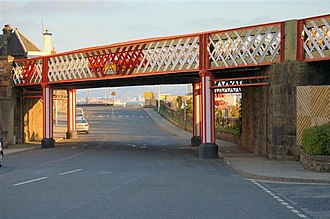Burntisland
| Burntisland | |
| Fife | |
|---|---|
 Burntisland | |
| Location | |
| Grid reference: | NT233859 |
| Location: | 56°3’36"N, 3°13’50"W |
| Data | |
| Population: | 5,940 (est) |
| Post town: | Burntisland |
| Postcode: | KY3 |
| Dialling code: | 01592 87 |
| Local Government | |
| Council: | Fife |
| Parliamentary constituency: |
Kirkcaldy and Cowdenbeath |
Burntisland is a town and royal burgh in Fife, on the Firth of Forth. According to an estimate taken in 2008, the town has a population of 5,940.
The town has a popular beach, and is know too for the 15th century Rossend Castle, and its traditional summer fair and Highland games day. To the north of the town a hill called The Binn is a landmark of the Fife coastline; a volcanic plug, it rises 632 feet above sea level.
History
Early evidence of human activity in this area has been found in rock carvings on The Binn, thought to be about 4000 years old. The Roman commander Gnaeus Julius Agricola used the natural harbour and set up camp at the nearby Dunearn Hill in 83 AD.
The earliest historical record of the town was in the 12th century, when the monks of Dunfermline Abbey owned the harbour and neighbouring lands.[1] The settlement was known as Wester Kinghorn and developed as a fishing hamlet to provide food for the inhabitants of Rossend Castle.[2] Ownership of the harbour was then sold to King James V by the abbots of Dunfermline Abbey in exchange for a parcel of land.[2] The land was granted royal burgh status by James V in 1541.[1] When the status was confirmed in 1586, the settlement gained independence from the barony of Kinghorn and was renamed Burntisland,[2] possibly a nickname from the burning of fishermens' huts on an islet now incorporated into the docks.[3] The town became so well established, that a new church known as St Columba's was built in 1592.[4] This was the first new parish church built in Scotland after the Reformation. It is a unique shape, square with a central tower upheld on pillars, and lined all round with galleries, to allow the greatest number of people to be reached by the minister's words during the service. The church contains one of the country's finest collections of 17th century and early 18th century woodwork and paintings.
Surprisingly, substantial remains of the original parish church, built in the late 12th century survive in a churchyard to the north of the old town.
In 1601, King James VI chose the town as an alternative site for the General Assembly of the Church of Scotland. This was where the first translation of the Bible was discussed.[4]
Burntisland developed as a seaport, being second only to Leith in the Firth of Forth, and shipbuilding became an important industry in the town. In 1633 one of the barges, the 'Blessing of Burntisland', carrying the baggage of Charles I and his courtiers from Burntisland to Leith sank with the loss of Charles' treasure.

Burntisland became an important port for the local herring and coal industries, and in 1847 the Edinburgh and Northern Railway opened from Burntisland north to Lindores and Cupar. By 1850 the world's first roll-on/roll-off rail ferry service was crossing the Firth of Forth between Burntisland and Granton, enabling goods wagons to travel between Edinburgh and Dundee without the need for unloading and re-loading at the ferries. (Passengers however had to disembark and use separate passenger ferries.) This ferry operated until 1890 when the Forth Bridge opened. In the late 19th century, the area experienced a short-lived boom in oil shale mining and processing at the Binnend Works.
Shipbuilding was a major 20th century industry until the shipyard closed in 1969. A plant for the refining of alumina was also opened in the early 20th century, closing in 2002. Industries related to the North Sea oil industry remain important for the town.
Burntisland Viaduct
Immediately to the west of Burntisland railway station stretches a 9-span viaduct which forms a significant feature in the harbour area of the town. Built in 1888 to carry the main railway line from Edinburgh to Dundee, it is now a Category C Listed structure, being a rare example of a surviving Town truss.

References
Outside links
| ("Wikimedia Commons" has material about Burntisland) |